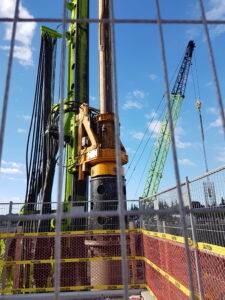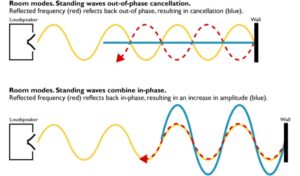
During my studies at the University of York (UK), I experienced the acoustical phenomenon of standing waves-without understanding (at the time), what the significance of that was. The photo above is Central Hall, with the Physics building in the background.
Let me explain: there was (include a photo of the University of York) a new student residence being built just outside the faculty of music at the university, and a large drill rig was being employed to establish the foundations of the new residence. The characteristic sound of the rig as it is doing its thing is a large, deep, thudding booming sound. Very nice.

Drill rig sound HERE
The university, established in 1963, circles a small lake. It is a lovely university, with parkland threading through, and surrounding the site. Almost directly across from the music faculty is the physics building, a five-storey glass-fronted building.
As I walked outside the faculty, and towards the lake, the sound of the drill rig was very prominent until I was 3 or 4 metres away from the faculty. The sound had almost completely dropped out. I turned around to see if the rig was still working. It was. Very strange! I continued walking, and the sound came back up, as though a giant hand had turned up the volume knob. What the heck?
The drill rig was producing a standing wave (as I briefly mentioned earlier): that is, when two travelling sound waves are propagating in opposite directions as a result of reflections inside a bounded system, be it a tube, string or room.
A sound wave is a vibration that propagates as an acoustic wave through different mediums. At 20 degrees Celsius, the speed of sound in air is about 343 metres/second.
The interference of these waves combine to create a resultant wave that appears to stand still at certain resonant frequencies (for example, the A4 key on the piano has a frequency of 440 Hz) called modes.
There is further discussion about the fundamental and harmonic partials/overtones that I won’t discuss here-but I will in another post.
In a listening environment, usually a room, or in my case, the distance between the construction site and the physics building: the standing waves will enhance or suppress certain frequencies in different parts of the room. Or about 4 metres away from the music faculty.

Basically, when I walked out of the music faculty, the booming sound was loud and constant. About 4 metres away, the sound dropped out because (see graph above) the standing wave created by the drill rig and its reflection off the glass-fronted physics building was out-of phase, resulting in its cancellation.
Although I didn’t get into acoustics until much later, this experience was a jumpstart for me into field recording, and more specifically, exploring the sounds of machines in factories, on construction sites and beyond.